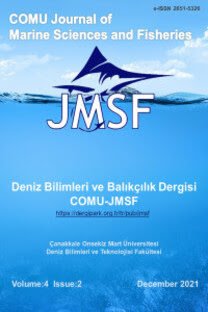Deniz Hıyarı (Holothuria tubulosa, Gmelin 1791) Ekstraktlarının Antioksidan ve Antimikrobiyal Aktivitesi
Holothuria tubulosa, Deniz Hıyarı Ekstraktı, Antimikrobiyal Aktivite, Antioksidan Aktivite, DPPH
Antioxidant and Antimicrobial Activity of Sea Cucumber (Holothuria tubulosa, Gmelin 1791) Extracts
Holothuria tubulosa, sea cucumber extract, antimicrobial activity, antioxidant activity, DPPH,
___
- Aleman, A., Santin, E.P., Juchereau, B., Arnaudin, I., Guillen, M.C.G., Montero, P. (2011). Squid gelatin hydrolysates with antihypertensive, anticancer and antioxidant activity. Food Research International, 44, 1044-1051. https://doi.org/10.1016/j.foodres.2011.03.010.
- Althunibat, O.Y., Ridzwan, H., Taher, M., Daud, J.M., Ichwan, S.J.A., Qaralleh, H. (2013). Antioxidant and Cytotoxic Properties of Two Sea Cucumbers, Holothuria edulis Lesson and Stichopus horrens Selenka. Acta Biologica Hungarica, 64(1), 10-20. https://doi.org/10.1556/abiol.64.2013.1.2.
- Aydın, M. (2008). The commercial sea cucumbers fishery in Turkey. SPC Beche de Mer Informaiton Bulletin, 28, 40–43.
- Aydın, M., Sevgili, H., Tufan, B., Emre, Y., Köse, S. (2011). Proximate composition and fatty acid profile of three different fresh and dried commercial sea cucumbers from Turkey. International Jorunal of Food Science and Technology, 46, 500-508. https://doi.org/10.1111/j.1365-2621.2010.02512.x.
- Bougatef, A., Balti, R., Haddar, A., Jellouli, K., Souissi, N., Nasri, M. (2012). Protein hydrolysates from Bluefin Tuna (Thunnus thynnus) heads as influenced by the extent of enzymatic hydrolysis. Biotechnology and Bioprocess Engineering, 17, 841–852. https://doi.org/10.1007/s12257-012-0053-y.
- Çaklı, Ş., Cadun, A., Kişla, D., Dinçer, T. (2004). Determination of quality characteristics of Holothuria tubulosa, (Gmelin, 1788) in Turkish sea (Aegean Region) depending on sun drying process step used in Turkey. Journal of Aquatic Food Product Technology, 13, 69–78. https://doi.org/10.1300/j030v13n03_07.
- Devienne, K.F., Raddi, M.S.G. (2002). Screening for antimicrobial activity of natural products using a microplate photometer. Brazilian Journal of Microbiology, 33, 166-168. https://doi.org/10.1590/s1517-83822002000200014.
- Dobretsov, S., Al-Mammari, I.M., Soussi, B. (2009). Bioactive Compounds from Omani Sea Cucumbers. Agricultural and Marine Sciences, 14, 49-53. https://doi.org/10.24200/jams.vol14iss0pp49-53.
- Esmat, A.Y., Said, M.M., Soliman, A.A., El-Masry, K.S.H., Badiea, E.A. 2013. Bioactive compounds, antioxidant potential, and hepatoprotective activity of sea cucumber (Holothuria atra) against thioacetamide intoxication in rats. Basic nutritional investigation, 29, 258-267. https://doi.org/10.1016/j.nut.2012.06.004.
- Liu, X., Sun, Z., Zhang, M., Meng, X., Xia, X., Yuan, W., Xue, F., Liu, C. (2012). Antioxidant and antihyperlipidemic activities of polysaccharides from sea cucumber Apostichopus japonicus. Carbohydrate Polymers, 90, 1664-1670. https://doi.org/10.1016/j.carbpol.2012.07.047.
- Mashjoor, S., Yousefzadi, M., Pishevarzad, F. (2018). In vitro biological activities of holothurians edible sea cucumbers in the Persian Gulf. Indian Journal of Geo Marine Sciences, 47(07), 1518-1526. http://nopr.niscair.res.in/handle/123456789/44598.
- Molyneux, P. (2004). The use of the stable free radikal diphenylpicryllhydrazly (DPPH) for estimating antioxidant activity. Songklanakarin Journal of Science and Technology, 26, 211-219.
- Murniasih, T., Putra, M.Y. and Pangestuti, R. (2015). Antioxidant Capacities of Holothuria Sea Cucumbers. Annales Bogorienses, 19, 2. http://dx.doi.org/10.14203/ann.bogor.2015.v19.n2.21-26.
- Nobsathian, S., Tuchinda, P., Sobhon, P., Tinikul, Y., Poljaroen, J., Tinikul, R., Sroyraya, M., Poomton, T., Chaichotranunt, S. (2017). An antioxidant activity of the whole body of Holothuria scabra. Chemical and Biological Technologies in Agriculture, 4, 4. https://doi.org/10.1186/s40538-017-0087-7.
- Öztoprak, B., Doğan, A., Dağlı E. (2014). Checklist of Echinodermata from the coasts of Turkey. Turkish Journal of Zoology, 38, 892-900. https://doi.org/10.3906/zoo-1405-82.
- Peng, X., Xiong, Y.L., Kong, B. (2009). Antioxidant activity of peptide fractions from whey protein hydrolysates as measured by electron spin resonance. Food Chemistry, 113, 196-201. https://doi.org/10.1016/j.foodchem.2008.07.068.
- Qi, H., Li, N., Zhao, X., Xu, Z., Qi, L. (2016). Physicochemical Properties and Radical Scavenging Capacities of Pepsin-Solubilized Collagen from the Body Wall of Starfish (Asterina pectinifera). Journal of Aquatic Food Product Technology, 26(4), 376-389. https://doi.org/10.1080/10498850.2016.1186768.
- Sun, H.H., Mao, W.J., Chen, Y., Guo, S.D., Li, H.Y., Qi, X.H., Chen, Y.L., Xu, J. (2009). Isolation, chemical characteristics and antioxidant properties of the polysaccharides from marine fungus Penicillium sp. F23-2. Carbohydrate Polymers, 78, 117-124. https://doi.org/10.1016/j.carbpol.2009.04.017.
- Yayın Aralığı: 2
- Başlangıç: 2018
- Yayıncı: Çanakkale Onsekiz Mart Üniversitesi Deniz Bilimleri ve Teknolojisi Fakültesi
Akyatan Lagünü (Karataş, Adana) Diyatom ve Dinoflagellat Topluluklarının Zamansal Değişimi
İldeniz PINAR, Sukran YALÇIN OZDİLEK
İbrahim Ender KÜNİLİ, Fatma Arık ÇOLAKOĞLU
Büyükeceli Sahilindeki (Kuzey-Doğu Akdeniz) Centrolophus niger (Gmelin, 1789)’in Yeni Lokalite Kaydı
Deniz ERGÜDEN, Deniz AYAS, Nuray ÇİFTÇİ, Mısra BAKAN
Titanyum Dioksit ve Nano Titanyum Dioksit Kullanımının Su Ürünlerine Olası Zararları
